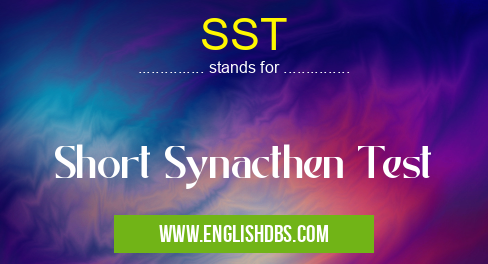What does SST mean in MEDICAL
The Short Synacthen Test (SST) is a clinical test used to diagnose adrenal gland insufficiency. It is an important part of diagnosing primary and secondary adrenal insufficiency, both of which can cause a range of symptoms including fatigue, low blood pressure, and difficulty regulating blood sugar levels. The SST measures cortisol levels in the body to determine if the adrenal glands are functioning correctly. When these levels fall below what is considered normal, it indicates that the adrenal glands are not performing as they should.

SST meaning in Medical in Medical
SST mostly used in an acronym Medical in Category Medical that means Short Synacthen Test
Shorthand: SST,
Full Form: Short Synacthen Test
For more information of "Short Synacthen Test", see the section below.
What SST Means
SST stands for Short Synacthen Test. This diagnostic procedure evaluates the level of cortisol in the body to check if there are any malfunctions in the body's production or secretion of this important hormone. It involves taking a basic blood sample from a patient before and after administering a synthetic version of ACTH (adrenocorticotropic hormone) into their veins through an injection. Cortisol is sometimes referred to as "the stress hormone" because it helps regulate bodily functions such as energy production, blood sugar balance, immune response, and more during periods of physical or mental stress. By administering a synthetic version of ACTH and measuring the cortisol response, doctors can assess if an individual's adrenal glands are working correctly or not.
Procedure For Performing SST
The process for performing SST typically takes about 30 minutes to complete. First, a sample of blood will be taken from the patient via venipuncture prior to administration of synthetic ACTH intravenously. After that injection has been given, another small sample will be taken again approximately 30-45 minutes after administration so doctors can measure cortisol levels in both samples and compare them against one another for analysis. Depending on how much hormones have been produced in response to ACTH stimulation can indicate whether an individual's adrenal glands are functioning properly or not.
Essential Questions and Answers on Short Synacthen Test in "MEDICAL»MEDICAL"
What is the SST?
The Short Synacthen Test (SST) is a medical test used to diagnose adrenal insufficiency. It measures cortisol levels by injecting a synthetic form of the hormone called Synacthen and then measuring the amount of cortisol in the blood 30 minutes later.
Who needs an SST?
An SST may be recommended for people who are showing symptoms of adrenal insufficiency, such as fatigue, low blood pressure, or muscle weakness. People with certain chronic illnesses, like diabetes or Addison's disease, may also need an SST.
How is the SST performed?
The patient will receive an injection of Synacthen into their arm or buttock muscle and then have their cortisol levels measured 30 minutes later. Blood samples may be taken before and after the injection in order to measure cortisol levels accurately.
Is there any reason why I should not get the SST?
If you are pregnant or allergic to Synacthen or any other ingredient in the syringe, you should let your doctor know before getting an SST. You should also inform them if you have had any recent surgeries or health conditions that could affect your results.
Are there any risks associated with having an SST?
There is a very small chance that you may experience side effects from the injection such as pain at the site of injection, nausea, faintness, headache and flushing. In rare cases, patients can develop an allergy after receiving a synacthen injection.
How long does it take to get my results back from an SST?
It typically takes between one and two weeks to receive your results after taking an SST. Your doctor will interpret your results and discuss them with you when they come back.
Can I expect any immediate effects during/after my test?
You may experience phsycial sensations such as increased heart rate, sweating or shakiness due to adrenaline release in response to the Synacthen injected into your body during testing. However these feelings usually subside shortly after testing has finished.
Do I need someone else to take me home after having this test done?
Generally no but it depends on what type of sedative has been administered prior to testing so it's important to ask your doctor about this ahead of time and make sure someone else is available if needed.
Does insurance cover a Short Synacthen Test (SST)?
Whether insurance covers a Short Synacthen Test (SST) depends on your specific health plan and what kind of coverage it offers for diagnostic tests like this one. You should contact your insurance carrier directly for more information on what kind of coverage you have.
Final Words:
In summary, the Short Synacthen Test (SST) is a medical procedure used to diagnose adrenal gland insufficiency by measuring cortisol levels in the body following stimulation from synthetic ACTH injections into veins via venipuncture. The results obtained from this test will help doctors determine whether or not an individual's hormones are being regulated normally by their body and enable them to further investigate any potential underlying issues with their endocrine system more thoroughly.
SST also stands for: |
|
| All stands for SST |
